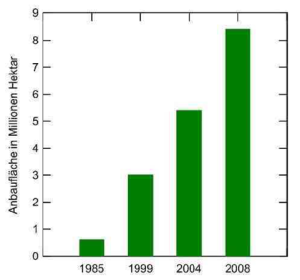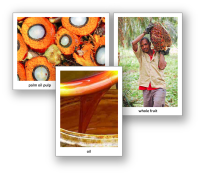Since my researches for the last Blog entry I start to realize that palm oil is a very hot discussed topic. It is so easy to find information about palm oil in the internet. Particularly environmental organisations offer a lot of information material. While my search I ran into a video:
The video has been produced by Greenpeace in order to call attention to the processing of Palm Oil at Nestlé. The blog of Greenpeace Germany comments the video this way: “Nestlé purchases huge amounts of palm oil from the company Sinar Mas, which abolishes rainforests on a large-scale for their plantations. Therewith Nestlé is a complicit for the extermination of the Orang-Utan. […]”
The issue 02/2011 of the German paper natur+kosmos explains the reason why palm oil is such a big problem (yes it’s a problem, not an issue) for the rain forest: “acreage-nomadism. […] Often the next piece of rainforest is getting uprooted in order to cultivate new oil palms. Is this acreage then literally at its end as well, it’s the next’s turn. A common practise, especially in Indonesia and Malaysia, the two main suppliers of palm oil.”
Also the web pages of www.faszination-regenwald.de inform (a bit fatalistic) about palm oil.

Palm Oil cultivation of the last years
- The cultivation areas for palm oil in Indonesia have increased continuously in the last 30 years […] from 0,6 million hectares in 1985, […] until 5,4 million hectares in 2004. Trend: upwards! In the year 2008 8,4 million shall be reached […], Applications to transform further 20 million hectares are made. This acreage is equal to the area of the remaining untouched rainforests in Indonesia. (That means after they have been approved, there is no more rainforest at all in Indonesia)
- South America catches up. In Columbia much rainforest is being spoilt in order to cultivate oil palms. Ground is cheap in Amazonia, cheaper than in South Asia – That whets the appetite of the palm oil industry.
- The […] boom of biofuels is not ecological at all, as the prefix “bio” would suggest. The EU environment secretaries resolved in march 2007 to increase the proportion of biofuels in petrol and diesel until 2020 up to 10%. But our local acreages are not sufficient to produce those 10% alone from rapeseed-oil […] By the promotion of biofuel Europe became the biggest importer for palm oil.

sample stock price for palm oil
- Since the boom of biofuels the demand for palm oil almost exploded. Within the last 10 years the worldwide consumption of palm oil doubled.
In another Article of the “Zeit” I find a few more facts:
- Currently there are around 7 Million hectares of oil palm plantations in Indonesia.
- In the last 20 years the plantations acreages have almost increased to their decouple. One driver of this expansion is the demand for biofuels.
- In the year 2008 around 43 million tonnes of palm oil and palm kernel oil have been produced. Currently it shall be around 45 million tonnes per year.
In a Greenpeace article I find the following:
- Germany imports around half a ton of palm oil per year. After the Netherlands therewith Germany is the second biggest consumer of palm oil in the EU.
At least there is an (even if not perfect) alternative for the classic palm oil: Sustainable Palm Oil. When the palm trees get too old and too high, new seedlings are planted to replace them. The acreages stay preserved for the palm oil cultivation on a long term.
But only a fraction of the worldwide palm harvest has a sustainable– or RSPO-label. Furthermore even this sustainable palm oil is criticised, as still forests are stubbed for this palm oil as long as the demand raises. Also corruption demolished the idea of sustainable palm oil as the path of sustainable palm oil from production to the end-user is not traceable without gaps.
E.g. Ralf Michel of the Borneo Orang-Utan-Help writes in a forum: “Suggestion: A sustainable Planter in Malaysia exports his goods per ship. The necessary export documents are provided by the local toll offices. In the same harbour at the same time next to the 20 tonnes sustainable palm oil, 20.000 tonnes of convenient palm oil are being transacted. And behold, on a wondrous way 20 tonnes sustainable palm oil become 20.020”
That all sounds horrible to me. Apart from those bloody pictures of death Orang-Utans and cutover forests I am quite shocked what immense impact the palm oil production has to our planet. One thing becomes clear: I don’t want to support manufacturers who use palm oil and rather will buy products which resign from palm oil. But where to start? How can I find out which products to buy and which not? In the end of the day Greenpeace will not produce videos against every manufacturer, as they did against Nestlé. And to be honest, I wouldn’t want to see them all.




[…] Rainforest vs. Palm Oil (ecodaily.wordpress.com) […]
[…] Rainforest vs. Palm Oil (ecodaily.wordpress.com) […]